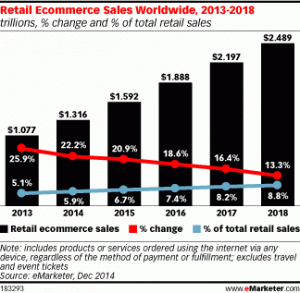Online to Offline: Trend or Reality for 2015?

 A new year has come to our lives before many of us could realize it. Retailers are always wondering how consumer habits will affect to their businesses and what will be the next trends for the economy or in IT. Therefore, we have decided to take a closer look at the 2015 retail landscape, based on what the industry leaders forecast.
A new year has come to our lives before many of us could realize it. Retailers are always wondering how consumer habits will affect to their businesses and what will be the next trends for the economy or in IT. Therefore, we have decided to take a closer look at the 2015 retail landscape, based on what the industry leaders forecast.
Online Retail Sales Growth
It seems pretty clear that online retail sales will experience steady growth, but it will only represent less than 6% of the total retail market worldwide, according to eMarketer forecast. This trend, confirms what we already forecasted in July 2014, that despite the rapid growth of online retail, physical stores will continue to be the main driver of total retail sales for several more years to come.
Shopping experience as a key factor
The shopping experience becomes one of the most important issues for the retailer, especially for brick-and-mortar ones, which are taking a new role in the commerce marketplace. A clear example of this is Mall of America, which will be implementing Wi-Fi into its 4.2 million square-foot venue later this year in an effort to bolster the customer experience.
Big online retailers focused on the offline world
As a result of all this, pure online retailers, such as Amazon or Zappos have turned their attention to the offline world.
- Amazon: Will open its first-ever brick-and-mortar site in Manhattan, according to the wall street journal. Going offline provides an opportunity to sync online data with offline experiences in a useful way. Knowing a customer´s size, style, and habits can really spice up the in-store experience, allowing the company to “pre-curate dresses, suggest items to take home or purchase later, and send them links to their updated profile,”
- Zappos: The famous online powerhouse has opened its first
–ever freestanding pop up store, a 20.000 square foot space in downtown Las Vegas. As you move through the store, you’re adding to a shopping cart existing in the physical and virtual world simultaneously.
Benefits of O2O (online to offline)
For e-tailers, there are some strong reasons to jump into the physical world, such as:
- Store Fulfillment: A number of multi-channel merchants have begun to fulfill orders from in-store inventory. Macy’s, for example is working to outfit approximately one-third of its retail outlets with the ability to fulfill online orders. Macy’s has two goals. First, to cut shipping costs and increase the speed of delivery by moving distribution points closer to buyers. Second, to avoid the need to mark down slow-moving store products when they are still in demand at full price online.
- IT Stores: Retailers are increasingly enhancing the in-store experience through interactive technologies. For example, John Lewis has introduced self-service kiosks, Wi-Fi and QR codes, and is trying the use of iPads in shops. Customers benefit from face-to-face customer service and the ability to feel the product, but they can also access the online channel to view products not available in store and arrange a delivery that suits them. “Traditional retailers can compete with, and even beat, the online pure-plays, essentially because they offer the brands that shoppers want and the social contact that still defines shopping,” says Chris Donnelly, head of Accenture’s retail practice for the UK and Ireland. It seems like technology is going to be a real advantage for brick-and-mortar retailers in 2015, pointing out 3 specific topics above all:
- Mobility: Retailers are investing in new e-commerce technology that encourages consumers — often with smartphones in hand — to shop strategically for deals inside physical stores. By “checking in” with your mobile device after you walk into a retail store — and offering some personal data including your location — shops in turn offer targeted digital deals right to your smartphone for immediate redemption. And this is only one of the possibilities that mobility has to offer in the retail market.
- RFID technology: RFID is an ID-identification-system. It relies on a small chip that is implanted in a tag. The tag can be attached to all sorts of things: merchandise, shipping containers, etc. Then, an electronic scanner can use radio signals to read or track the ID tag.
- Mobile Payments: Big retailers are muscling in on the likes of Visa, MasterCard and Google in a fiercely competitive and growing mobile payment market that promises to cut transaction costs and increase customer loyalty.
After all that has been said, it is reasonable to think that the change from e-commerce to brick-and-mortar stores will be a growing trend for years to come. Actually, despite the fact that the majority of, for example, US consumers are making purchases online, more than $10 out of every $11 in that country are still spent in physical stores. We will see in 2015 if this trend is confirmed.
What do you think? Will the Online-to-Offline be more than a trend in 2015? Let me hear your thoughts.




No Comment